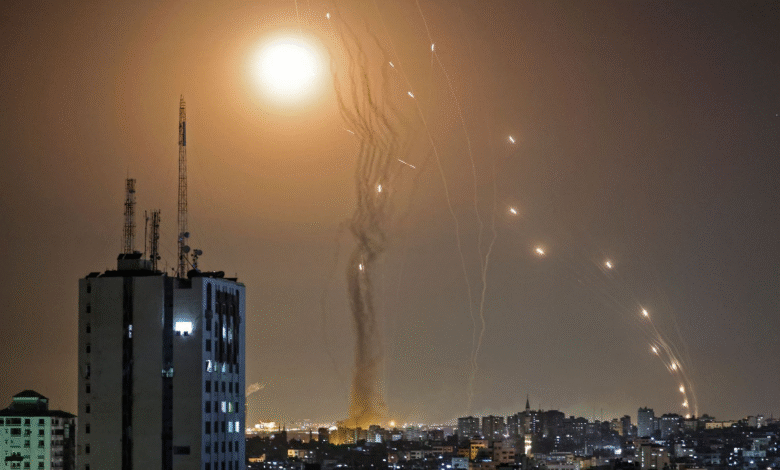Iron Dome: Israel’s Advanced Missile Defense System Explained

The Iron Dome missile defense system, also known as “Kippat Barzel” in Hebrew, stands as a crucial line of defense for Israel, shielding its citizens from aerial threats. This sophisticated Israel missile defense technology was specifically designed to counteract incoming rockets, providing a vital layer of security against short-range projectiles. Since its deployment in 2011, the Iron Dome system has demonstrated remarkable efficiency in rocket interception, successfully neutralizing numerous threats before they could endanger populated areas. Developed in collaboration with U.S. support, the Iron Dome signifies a strategic advancement in missile defense systems worldwide. Its innovative approach not only protects lives but also reinforces Israel’s commitment to safeguarding its population against persistent hostilities.
Often referred to as a protective shield, the Iron Dome serves as Israel’s premier defense mechanism against airborne assaults, encompassing a broad spectrum of threats. This advanced interception system has garnered attention for its remarkable capability to detect and neutralize incoming projectiles, thereby ensuring the safety of urban centers and key infrastructure. Through its cutting-edge technology and robust operational structure, this defensive system exemplifies modern warfare solutions. The strategic importance of the Iron Dome extends beyond mere defense; it encompasses geopolitical implications crucial for regional stability. As military engagements evolve, the Iron Dome’s impact and effectiveness will remain a focal point of discussion among defense analysts and policymakers alike.
Understanding the Iron Dome System: Key Features and Capabilities
The Iron Dome system, known as “Kippat Barzel,” is a technological marvel that underscores Israel’s commitment to missile defense. It employs advanced radar technology to detect and track various aerial threats, providing a swift response to incoming rockets. Once a potential threat is identified, the system distinguishes between harmless and dangerous projectiles, allowing for targeted interceptions. This capability ensures that residential areas and important sites are safeguarded from rocket attacks, significantly enhancing national security.
Operational since 2011, the Iron Dome features a robust infrastructure that includes multiple batteries spread across the nation. Each battery is equipped with several launchers and Tamir interceptors designed to engage threats at a range of 2.5 to 43 miles. This flexibility and expanded reach make the Iron Dome a critical component of Israel’s integrated air defense strategy, capable of dealing with varying levels of rocket fire and enhancing the protection of Israeli populations against sudden aerial assaults.
The Benefits of Iron Dome Technology in Modern Warfare
One of the primary benefits of the Iron Dome technology is its contribution to civilian safety. By intercepting rockets mid-air, the system has significantly reduced the number of casualties during conflicts. The effectiveness of this defense mechanism provides reassurance to Israeli citizens, allowing them to go about their daily lives with a greater sense of security despite the ongoing threat of missile attacks. This psychological impact is as important as the physical interception, as it strengthens public morale during times of tension.
Additionally, the Iron Dome system enhances Israel’s military capabilities by allowing the Israel Defense Forces (IDF) to manage their resources more effectively. With the ability to neutralize aerial threats, the IDF can focus on broader strategic objectives without the constant need to divert attention to incoming threats. This aspect also allows for coordinated responses in military operations, increasing Israel’s readiness and effectiveness on the battlefield.
However, it is also essential to recognize the financial investment involved in developing and maintaining such sophisticated technology. The cost of operating and producing the Iron Dome is significant, with estimates suggesting that a single battery could exceed $100 million. The ongoing support from the United States through funding and collaborative projects emphasizes the strategic alliance between the two nations while showcasing the system’s importance in regional defense.
The sustained partnership between the U.S. and Israel in developing the Iron Dome system reflects broader geopolitical trends. As international security threats evolve, the demands on missile defense systems increase, leading to continuous improvements in Iron Dome technology. This includes advancements in interception capabilities and radar technology, ensuring the system remains effective against new types of threats that challenge traditional defense strategies.
Iron Dome’s Response to Rocket Interception Challenges
While the Iron Dome system is celebrated for its successful interceptions, it is not without its limitations. One of the critical concerns raised by military analysts relates to the potential for saturation attacks. In such scenarios, multiple rockets may be launched simultaneously from different locations, aiming to overwhelm the Iron Dome’s capability to intercept all threats. This vulnerability poses a significant challenge that could lead to breaches in defense and compromised safety for civilians.
Moreover, the system’s operational parameters dictate that it only intercepts rockets deemed a threat to populated areas or strategic assets, allowing others to land without interception. This selective targeting raises questions about the overall efficacy of the Iron Dome in scenarios involving high-volume attacks, where not every projectile can be engaged. Analysts suggest that for optimal protection, Israel may need to explore complementary systems that work in conjunction with the Iron Dome to address potential shortcomings.
The Strategic Importance of Iron Dome in Israel’s Defense Posture
The Iron Dome’s role in Israel’s military strategy is undeniably crucial. As a frontline defense mechanism, the system plays an integral part in the broader framework of Israel’s national security strategy, which includes air superiority and comprehensive defense against a range of threats. Its effectiveness directly impacts Israel’s geopolitical standing and its ability to deter potential aggressors in a highly volatile region.
Furthermore, the technology and innovations derived from the Iron Dome project are likely to influence global defense initiatives. Countries observing the system’s success may be motivated to develop similar technologies or systems, leading to international collaborations and advancements in missile defense. This trend reflects the Iron Dome’s potential as a model for other nations seeking to enhance their missile defense capabilities while ensuring civilian safety in conflict zones.
Economic Implications of the Iron Dome System
The economic considerations surrounding the Iron Dome system extend beyond initial costs and investments. Notably, the financial assistance that Israel receives from the United States for Iron Dome maintenance and upgrades highlights the system’s role not just in defense but also in fostering economic relations between nations. This funding facilitates continuous improvements to the technology and ensures its operational readiness, showcasing the economic synergy in international defense collaborations.
Additionally, the manufacturing and development of Iron Dome technology stimulate the Israeli defense sector, creating jobs and promoting technological innovation domestically. As one of the most important assets in Israel’s defense arsenal, the Iron Dome supports not just military needs but also economic growth, drawing interest and investments that contribute to advancements in the broader field of defense technology.
The Iron Dome and Global Defense Collaborations
In recent years, the success of the Iron Dome has prompted discussions on global defense collaborations, with several countries looking to Israel for expertise in missile defense systems. As the demand for advanced interception technologies grows worldwide, nations recognize the importance of forming partnerships with Israel to enhance their own security measures. This collaboration fosters technology sharing and joint development projects, harnessing Israel’s advancements in missile defense solutions.
As military conflicts evolve and new challenges arise, the Iron Dome—inspired technology—could become a vital component of international military cooperation efforts. Such partnerships exemplify how domestic expertise can be leveraged on a global scale, promoting collective safety and reinforcing geopolitical alliances. This symbiotic relationship not only strengthens individual nations’ defenses but also enhances international stability.
Future Developments in Iron Dome Technology
The trajectory for the future of Iron Dome technology is poised for innovation and enhancements as new threats emerge in global security. Continuous developments in missile interception capabilities, sensor technologies, and machine learning will likely shape the next generation of the Iron Dome system. As Israel continues to invest in research and development, the system can adapt to counteract evolving threats, ensuring it remains at the forefront of missile defense technology.
Furthermore, collaborations with international defense firms could bring fresh perspectives and technological insights, paving the way for even more sophisticated interception capabilities. As advancements in artificial intelligence and drone technology become prevalent, integrating such innovations into the Iron Dome framework could further enhance its operational effectiveness and responsiveness against diverse aerial threats.
Iron Dome’s Role in Deterring Regional Threats
In the context of regional threats, the Iron Dome serves as a powerful deterrent against hostile actors. By demonstrating the capability to effectively intercept incoming rockets, Israel communicates a strong message to adversaries: attacks will not go unanswered. This strategic posture is crucial in maintaining a balance of power in a region characterized by rapid change and various security challenges.
Moreover, the operational success of the Iron Dome has the dual effect of reassuring Israeli citizens and enhancing deterrent capabilities against potential aggressors. As the system protects population centers and critical infrastructure, adversaries may reconsider the feasibility of launching attacks, knowing the high likelihood of interception. This psychological edge is an essential facet of Israel’s broader defense strategy.
Challenges and Limitations of the Iron Dome System
Despite its successes, the Iron Dome system is not infallible and faces several challenges that could impact its effectiveness in future conflicts. As technology advances, potential adversaries may develop countermeasures specifically designed to circumvent the Iron Dome’s interception capabilities. This arms race between offensive technologies seeking to breach defenses poses a significant concern for military strategists.
Additionally, the reliance on a single system can lead to vulnerabilities in Israel’s overall defense architecture. Should there be a series of attacks that exceed the system’s capabilities, or should other forms of attack—such as drones—become prevalent, Israel must ensure that its defense strategy encompasses more than just the Iron Dome. Exploring a multi-layered defense strategy could provide a more resilient approach to countering various forms of aerial threats.
Frequently Asked Questions
What is the Iron Dome system and how does it work?
The Iron Dome system, known as ‘Kippat Barzel’ in Hebrew, is a mobile missile defense technology designed by Israel to intercept and destroy short-range aerial threats. It operates by using radar to track incoming rockets, assessing whether they pose a threat to protected areas. If deemed dangerous, the system launches Tamir interceptors to neutralize the threat mid-air.
What are the key features of the Iron Dome technology?
Key features of the Iron Dome technology include advanced radar systems for tracking incoming projectiles, command and control centers for decision-making, and multiple Tamir interceptor launchers capable of handling simultaneous threats. This sophisticated system enables rapid response to aerial attacks, safeguarding populated areas.
How successful is the Iron Dome missile defense system?
The Iron Dome missile defense system has seen significant success since its operational debut in March 2011, reportedly intercepting numerous rockets and preventing them from hitting Israeli communities. According to the Israeli Defense Ministry, this has saved countless lives and minimized damage during conflicts.
What are the limitations of the Iron Dome system?
Despite its effectiveness, the Iron Dome system has limitations, particularly in scenarios involving intense or ‘saturation’ rocket attacks. Analysts warn that simultaneous missile assaults from multiple directions can overwhelm the system, leading to potential breaches in defense.
How has U.S. support influenced the development of the Iron Dome?
U.S. support has been crucial for the development and funding of the Iron Dome system, with billions of dollars allocated for its batteries and technological improvements. This funding has been reinforced by bipartisan support in Congress, demonstrating the strong U.S.-Israel defense relationship.
Where are Iron Dome batteries deployed in Israel?
Iron Dome batteries are strategically deployed across Israel, with at least 10 batteries in operation. Each battery is designed to protect a 60-square-mile area, ensuring comprehensive coverage against potential rocket threats.
What kind of threats does the Iron Dome interject against?
The Iron Dome is specifically designed to intercept short-range threats, including rockets, mortars, and artillery shells, typically launched from a distance of 2.5 to 43 miles away. Its primary goal is to protect civilian areas and critical infrastructure.
Who developed the Iron Dome system?
The Iron Dome system was developed by Rafael Advanced Defense Systems, a state-owned company in Israel, with significant financial backing and collaboration from the United States, highlighting the strategic importance of missile defense technology in Israel’s national security.
| Feature | Details |
|---|---|
| System Name | Iron Dome (Kippat Barzel) |
| Operational Since | March 2011 |
| Purpose | Protect Israeli citizens from aerial attacks |
| Key Features | Radar tracking, guided missile interception, mobile all-weather capability |
| Range of Operation | 2.5 to 43 miles |
| Number of Batteries | At least 10 batteries deployed |
| Cost | Over $100 million per battery |
| Recent Funding | Billions of dollars from U.S. for production and maintenance |
| Weaknesses | Vulnerable to saturation attacks from multiple directions |
Summary
The Iron Dome is a critical component of Israel’s missile defense strategy, designed to intercept and neutralize aerial threats to protect its civilian population. Since its operational deployment in 2011, it has demonstrated effectiveness against incoming rockets, bolstered by substantial U.S. financial support and continual upgrades. Its technological capabilities, however, reveal inherent vulnerabilities, particularly when faced with overwhelming simultaneous missile attacks. Overall, the Iron Dome remains a pivotal factor in Israel’s national security framework.




